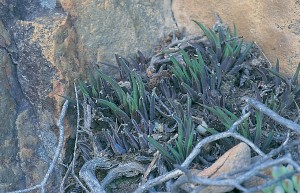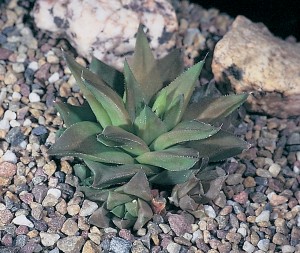1. Haworthia angustifolia Haw., Phil.Mag. 46:283(1825), Baker, JLinn.Soc. 18:210(1880). Non Jacobsen 2:536(1954). Bayer :97(1976). Bayer :26(1982): Bayer, Nat.Cact.Succ.J 37:31(1981). Scott :54(1985). Type: Not preserved. Neotype (designated here): icon, 13:f2, Salm-Dyck, Monogr. Epitype: CAPE-3326 (Grahamstown), Highlands (-AD), Cooke in NBG68977, non B&M Bruyns 1653 (NBG): Aloe stenophylla Roem. et Schult. Syst.Veg. 7:641(1829). Salm-Dyck, Monogr. 13.t2(1849). Type: As for H. angustifolia: H. angustifolia var. grandis Smith JS.Afr.Bot. 9:105(1943). Type: Cape, Albany Div, Smith 5216 (PRE): H. albanensis Shonl., Rec.Albany Mus. 2:256(1912). H. angustifolia var. albanensis (Shonl.) V.Poelln., Feddes Repert.Spec.Nov. 41:194(1937). Type: Cape, Grahamstown, Britten s.n. sub Triebner 835 (not preserved).
angustifolia: narrow leaved.
Rosette to 40mm φ, proliferous, stemless. Leaves 10-40, slender, erect to 100 X 10mm, lanceolate‑acuminate, sub-flaccid, brownish to dark green, margins and keel finely denticulate. Inflorescence to 200mm, lax. Flowers 8‑10, white to dull pinkish‑white.
1982 – The introduction of this species to Kew in 1824 is attributed to Bowie. It is a small clump-forming species with long narrow leaves, which has frequently been confused with H. chloracantha. However, it is a softer species and the marginal teeth are smaller and more closely spaced. The range of variation in both species is fairly similar. Smith’s var. paucifolia was based on a miniature form from Coombes, east of Grahamstown. Here the plants are miniaturised and growing within clumps of Restio among proteas. Across the valley, in grassveld, the plants are much more robust and this is the origin of var. grandis. Small forms are also found in grassveld along the edges of the lower Fish River Valley where only the short leaf-tips are visible above the soil in exposed rock cracks and crevices, sometimes shaded by grass. The Fish River seems to be the eastern limit and from there H. angustifolia extends westwards to the Zuurberg mountains. At Riebeeck East the leaves are particularly slender and this is probably the most attractive form to grow.

Haworthia angustifolia var. angustifolia JDV92/86 Coombs. Leaves are usually erect and straight.
H. baylissii was described from the farm Oudekraal not far from the Zuurberg Pass. It was first described as having broad, highly recurved leaves but plants collected by Bayliss at the same time and place, and grown at Kirstenbosch, were typical of normal H. angustifolia. Plants from the type collection also do not retain their character in cultivation although the leaves remain very deltoid and spreading. This prompted the idea that H. baylissii was only an odd form or hybrid of H. angustifolia. A visit to the type locality in 1979 confirmed this view (of form) as vast numbers of H. angustifolia were found growing on a rocky sandstone knoll overgrown with fynbos species (Protea spp., Restio spp.). This knoll was above a steep sided valley with the rocky faces clothed with succulents. H. glauca and H. cooperi were both present and seen in the immediate area. H. angustifolia must be considered to be a species of the False Macchia associated with acid quartzitic soils and in a moderate rainfall area. The False Macchia peters out west of the Zuurberg and occurs in small isolated patches in the Klein Winterhoek Mountains and Groot River Heights, apart from the main body further to the southwest. These areas have not been fully explored and it is possible that a relationship may extend between H. angustifolia, H. zantneriana and even H. divergens. H. angustifolia has been known to hybridise with H. cymbiformis at Howiesonspoort near Grahamstown, and the hybrid was described as H. perplexa V.Poelln.
H. angustifolia is easy to grow and the ease with which some forms proliferate may be an embarrassment. Under shaded conditions the leaves may also spread too much and lose the very dark colour that well-grown plants should have.
1999 – Scott selected a specimen to represent his concept of the species without specifically designating it as the type. The illustration in Salm-Dyck is available as the oldest and most generally used reference for the name, despite Fourcade’s discounting Baker’s description of H. angustifolia (see under H. monticola). The type selected by Breuer and Metzing is the specimen cited as representative for the species. It is an unfortunate choice because it represents a variation and is not typical of the species.
There have been no new collections to suggest any changes to the concept of this species. G. Marx has commented on the leaf length changing with favourable growing conditions and Cumming also correctly states that the var. paucifolia loses its distinctiveness in cultivation. Despite this it has been decided to recognise the following varieties:-

a. var. angustifolia
This is most commonly found in the environs of Grahamstown and has been collected as far west as the Zuurberg (NE. Kirkwood) where it occurs together and appears to intergrade with the var baylissii. It is not known east of the Fish River nor further north than Riebeek East. Scott refers to records from the south-western districts but these are unquestionably mis-identifications of either H. chloracantha or H. divergens. The latter both to a degree have markings on the leaves and in neither do the leaf-tips incline inwards as they do in H. angustifolia.
Distribution: 3325 (Port Elizabeth): Uyepoort, Zuurberg (-AD), C.H.F. Woolley (NBG); Somerset East to Zuurberg (-BB), Holland in NBG18/25 (BOL); Kommadagga Stn. (-BB), Stayner in KG688/71 (NBG); Annsvilla to Uitenhage (-BD), Smith 2540 (NBG). 3326 (Grahamstown): Albany(-AB), Britten in PRE 34949; Alicedale (-AC), Stayner in KG251/70 (NBG); Wireless Stn. (-AD), Highlands (-AD), Smith 7270, 7449 (NBG), Cooke in NBG68977; Fort Collingwood (-AD), Smith 639 (NBG); Howiesonspoort (-AD), Smith 911, 7440 (NBG); Timm (NBG); Grahamstown (-BC), Breijer in TRV 23226 (PRE); Mt. Drive (-BC), Dyer 2280 (PRE); Mt. Drive (-BC), Smith 5630 (NBG), Barnes (BOL), Dyer 5; Hospital Hill (-BC) Smith 5656 (NBG); Near Coombes (-BD), Smith 5216 (NBG, PRE); Trappes Valley (-BD), Britten (BOL); Bathurst (-BD), NBG 68060; Lincoln Siding (-DA), Smith 3839 (NBG). 3227(Kingwilliamstown): Paradisekloof, Britten 5676 (NBG);
Inadequately located: Grahamstown, Whitworth in NBG 901/23 (BOL); Bolus (BOL), van der Merwe 115 (BOL).

Haworthia angustifolia var. angustifolia JDV89/38 Woesthill Pass, east of Grahamstown. May develop large mats under shade. 
Haworthia angustifolia var. angustifolia JDV97/67 east of Grahamstown. Purplish shades develop in the leaf colour.
b. var. altissima Bayer var.nov. Type: CAPE-3326(Grahamstown): Riebeek East to Carlisle Bridge (-AA), Smith 5220 (NBG, Holo.).
altissima: tallest
Rosette proliferous. Leaves slender, erect to 150 X 10mm. Finely denticulate along the margins and keel. Leaf colour tending to greyish green rather than darker green. (A var. angunstifolia foliis griseo-viridibus erectioribus gracilibusque differt).
The var. altissima is created to accomodate a more distinctive taller element with more upright slender leaves than the var. grandis of Smith. The leaves in that variety are not particularly long for the species and neither this nor the distribution are as significant as may have been originally thought.
Distribution: 3326 (Grahamstown): Riebeek East to Carlisle Bridge (-AA), Smith 5220 (NBG); Sidbury (-AC), Smith 7450 (NBG); 32km Grahamstown to Alicedale (-AD), Bruyns 1653 (NBG).

Haworthia angustifolia var. altissima JDV97/66 Riebeek East. Note the greyer coloura of the leaves and the more conspicuous marginal spines.
c. var. baylissii (Scott) Bayer comb.nov. H. baylissii Scott, JS.Afr.Bot. 34:1(1968). Bayer :102(1976). Bayer, Nat.Cact.Succ.J 37:31(1981). Scott :101(1985). H. angustifolia fa baylissii (Scott) Bayer :26(1982): Type:- CAPE-3325 (Port Elizabeth): Oudekraal, Zuurberg (-BC), Bayliss in Scott 796 (PRE).
baylissii: for Col R.D.A. Bayliss.
P.V. Bruyns collected at the Oudekraal locality in 1993 and found again the forma baylissii, while independently Ernst van Jaarsveld recorded plants similar to the ordinary var. angustifolia from the same locality. The account in the New Handbook states that the Bayliss type collection represented at Kirstenbosch was atypical of the form described in that the leaves were not recurved. My own collection from Oudekraal was also not at all typical for Scott’s species as the leaves of the plants were not at all recurved and only slightly broader that in plants of the Grahamstown area. Neither this collection nor van Jaarsveld’s included any really broad leaved plants (nor with recurving leaves) which resembled true baylissii. Bruyns’ collection was made some 2-3km lower down the river valley where the plants were growing on rather sheltered rock ledges. The leaves of the plants were broader than either my or van Jaarsveld’s collections. The contention is that Scott’s species has neither the distribution, variability nor co-occurrence (other than with H. glauca and H. cooperi var. pilifera), to justify that status. Varietal status is propose because of the Bruyns re-collection. The concept is broadened somewhat to include plants with both narrower and non-recurved leaves.
Distribution: 3325 (Port Elizabeth): Zuurberg, Oudekraal (-BC), Bayliss in Scott 796 (PRE); Oudekraal (-BC), Scott in KG 416/70 (NBG); Oudekraal (-BC), Bayer 2052 (NBG).

Haworthia angustifolia var. baylissii co-type, Oudekraal. Only recorded from the Zuurberg at one locality, and most plants in the population have much narrower leaves than as described. This plant was grown at Kirstenbosch.
d. var. paucifolia Smith, JS.Afr.Bot. 14:48(1948). Type:- CAPE-3326 (Grahamstown): Frazers Camp (-BD), Smith 6819 (NBG).
paucifolia: with few leaves.
This variety is fairly abundant along the lower Fish River around the old Chalumna Police Station. This is a different grassland habitat to that at Frazers Camp where it was first recorded in Fynbos. This variety is not proliferous and the leaves flex outward. It is very small, with few leaves, seldom exceeds a height of about 7cm and the body of the plant is usually well drawn into the soil. These differences are not maintained in cultivation.
Distribution: 3326 (Grahamstown): Frazers Camp (-BD), Smith 6819 (NBG); Frazers Camp (-BD), Compton 19092 (NBG). 3327 (Kingwilliamstown): Kaffirdrift, Leach & Bayliss 12636 (PRE); Kaffirdrift (-AC), Bayliss 2592 (NBG).

Haworthia angustifolia var. paucifolia JDV97/64 Coombs. Tends to maintain small size in cultivation. 
Haworthia angustifolia var. paucifolia JDV97/1. Kfirdrift. In this variety the plants are single and only the leaf-tips are visible above ground.
[ed.] Also see Natural Variation and Species Delimitation in Haworthia Duval. – Part 5. HAWORTHIA ANGUSTIFOLIA Haworth. (1981)
